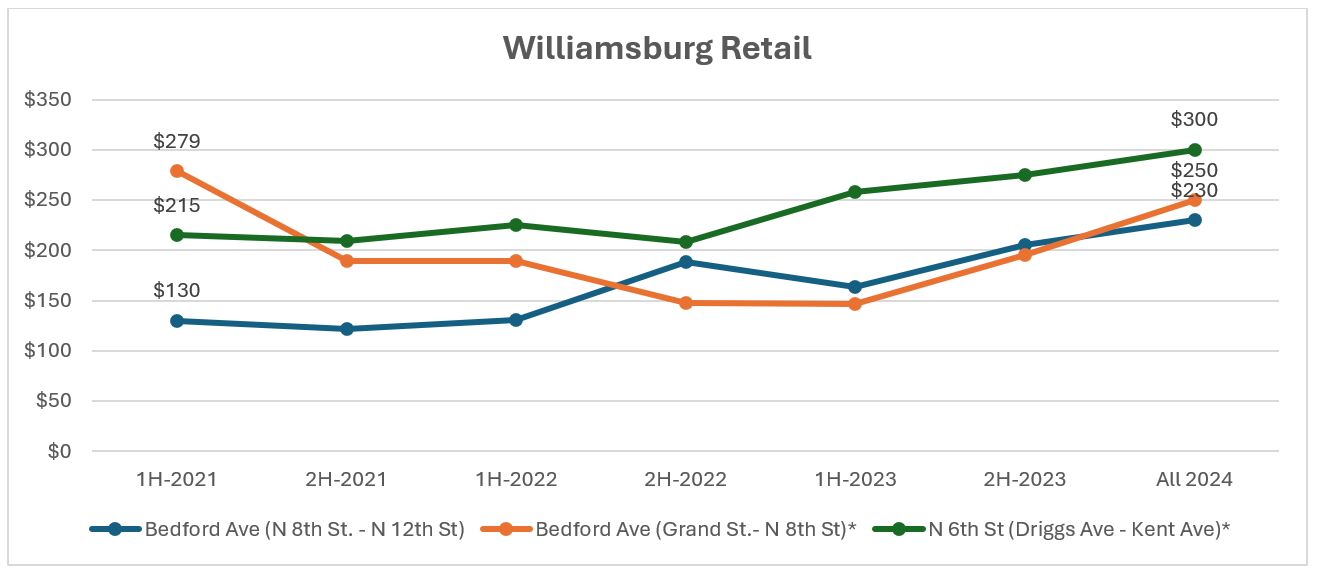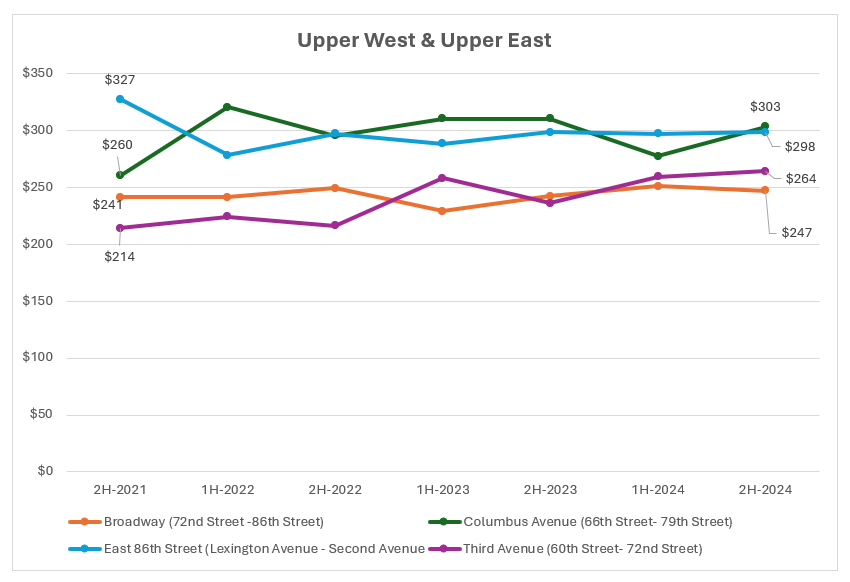Thoughts on Retail Real Estate in NYC
In the fifth week of our retail property sale, we have had to acknowledge investor feedback. The tenant’s rent is too high, and it will be very hard, neigh, impossible, to replace that rent if they vacate! That’s one we have received a lot, and I thought this was interesting because the same kind of tenant in a better location down the street has a very low rent and the feedback from investors is how problematic the low rent is. The feedback led me down a road of research around retail, which I will talk about today.
Risks / Challenges
Unlike owners of apartments in NYC, retail property owners must contend with the risks of months-long vacancies upon lease turnover. Many uncertainties come up at lease expiration time. Will the tenant exercise the option to extend? Will the tenant stay? If they stay, will they agree to the rent set forth in the initial lease agreement some 5, 10, or 15 years ago? If the tenant does vacate, how many capital reserves have investors allocated for moments “in between tenants”? When courting new tenants, how much $ are owners willing to spend on tenant improvement costs?
But, more important than how landlords negotiate the above matters is how the landlord structures the retail lease. How successful retail owners are in negotiating their leases is incredibly important. Unlike the daily rent resets for hotel owners or the yearly or bi-yearly rent resets for multifamily owners, retail owners must decide on rent schedules, in some cases, 15 years before the rent is paid (i.e., year 15 in a lease term). Retail owners must look out into the future to try and understand where the world and the local economy are headed (ideally pinpointing when inflation will grow into the double digits) and use that to try and structure favorable rents and terms for themselves.
My Sympathy for
All the illegal cannabis dispensary landlords (past and future)
All the former Blockbuster landlords
All the former SEARS landlords
All the Family Dollar landlords
All the Party City landlords
All the Walgreens landlords
Congratulations to
Landlords who negotiated large percentage (%) tenant tax payments on properties exposed to a risk of fast tax growth
Landlords who negotiated an option to remove tenants on real estate that was expected to see fast rent growth prior to lease term end
Landlords who picked tenants that pay on time and run a successful business
Landlords who picked tenants that could pay good base rent and that would also quickly start contributing revenue share rent
Big Stakes
The considerations I outlined apply to free-standing retail and retail property below apartments, to corner spaces and in-line retail, to smaller retail spaces, and to 100k + SF spaces. But, the stakes are much higher when the space is larger. If the project was a major repositioning that required signing on a fresh-faced retail tenant, getting that lease negotiated correctly is more important - especially when leverage or rent stabilization are involved.
Rent-stabilized buildings have lost ample value in NYC, and that is causing some distress for owners who levered up at the wrong time. However, some owners have been able to leverage the growth of the retail rents in their property's vicinity to obtain good exits despite tighter rent regulations.
A buyer recently mentioned buying a corner property with 6 apartments and 2 stores close to an important train station in NYC. It sold with 1 or 2 vacancies, but the cap rate on in-place numbers would have been around or below a ~5% cap rate at full occupancy. The property was fully rent-stabilized with several rents below $1,000. That's an estimated ~5% cap rate for a fully rent-stabilized property with at least 10% (conservatively) of purchase price in deferred maintenance. But, the investor/user was interested nonetheless. Because of the property's great location, the owner was able to obtain pre-2019 and pre-interest rate hike pricing! So, retail can add tremendous value to a property – especially some of the buildings that have seen their values collapse since HSTPA.
Location is a primary driver of rents and property values, especially for retail real estate. Investors consider whether the property is on the corner, opposite cars waiting behind a traffic light (signalized corner). They also look at how much frontage exists on a given commercial corridor, which will increase visibility for pedestrians. Or even how close the front retail store is to the train station. For some tenants like deli-grocery stores, it's practically a requirement to be on top of or directly across the street from the train stop. Other retail tenants strongly weigh what retail tenant mix already exists on the retail corridor to gauge how many sales they expect to get (for example, Hermes coming to North 6th street in Williamsburg thanks to all the hard work of Lululemon, Chanel, Le Labo, North Face, and The Google Store).
The Data
I looked at REBNY's retail analyses for retail rents in 2024 in Manhattan and in Brooklyn to understand where retail valuations might soon rise. See below for some of these charts on different retail categories in Brooklyn and Manhattan. The story by and large for Manhattan is sort of what you would expect.
“The average asking rent in 16 out of 17 corridors in this report remains at least 10% below prepandemic levels.”
Trendy Locations
Retail rents in Williamsburg’s primary retail corridors have all grown in the last four years and the charts are all up and to the right. Each corridor has shown growth, and the largest rent increase occurred in areas like North 8th – North 12th Street. This might be a result of retailers being priced out of North 6th Street and southern sections of Bedford Avenue, forcing them to start looking further up in Williamsburg. In Manhattan, the story is a bit more varied, supporting the idea that remote work has impacted where consumers shop, eat, and have fun. The stretch of Broadway in Tribeca has suffered, while parts of Bleecker Street have soared – doubling the average asking rent / sf since 2021.
Historically Affluent Areas
Rents in less trendy but more classically desirable locations in Brooklyn and Manhattan that contain more lifestyle retailers and benefit from fewer tourist populations and less foot traffic but still have a reliable base of local shoppers – these areas seem to be holding steady post-pandemic in Brooklyn. Rents in some areas have seen light increases, but a real growth movement has yet to take hold. Much the same can be said of Manhattan. Contrasting this data with the growth in ~trendier~ Williamsburg and Soho tells us that the retail market is converging toward the denser (thank you Bloomberg), more trafficked areas. Tourist dollars are headed to Soho and Williamsburg, and retailers are responding accordingly.
Additional Retail Rent Summaries from the Report Below
Brooklyn Average Asking Rents per SF in 2024
Manhattan Average Asking Rents per SF in 2H 2024
Investors in multifamily in NYC can avoid retail, but it may also be rewarding (and maybe fun?) to buy apartments with retail tenants below. Mixed-use properties can be strong hedges against new developments. More apartments nearby can pressure residential rents but offer a nice lift to retail rents.
Keep reading with a 7-day free trial
Subscribe to Romain Sinclair's NY Multifamily Newsletter to keep reading this post and get 7 days of free access to the full post archives.








